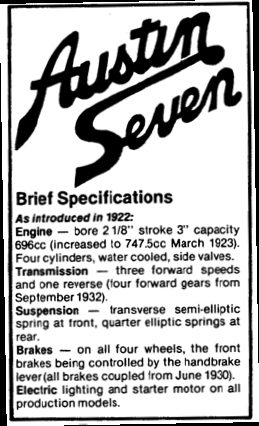THE
AUSTIN SEVEN – AN INTRODUCTION BY JOHN WILLIAMS
When Sir Herbert
Austin en-visaged the design of the legendary Austin Seven it was his intention
to capture the enormous market for a small, cheap, but entirely practical car -
a car which  would bring motoring within the reach of ordinary people instead of
a wealthy majority. He appreciated that Britain had just emerged from the First
World War which had brought thousands of young men into close contact with
motorised transport and brought about what amounted to a social revolution. He
meant to give them their own means of transportation.
would bring motoring within the reach of ordinary people instead of
a wealthy majority. He appreciated that Britain had just emerged from the First
World War which had brought thousands of young men into close contact with
motorised transport and brought about what amounted to a social revolution. He
meant to give them their own means of transportation.
In 1922 when the car
was introduced many, including most of the directors of the Austin Motor
Company believed that the tiny Seven was a joke that could not succeed and
would almost certainly ruin a company which was far from being financially secure.
In fact the Seven made the Austin Motor Company's fortune and remained in
production until 1939 by which time around 300,000 had been made.
While the Austin Seven
remained the butt of music hall jokes throughout its life the jokes became
affectionate and the car did play an important part in bringing motoring to the
masses, not only during its production life but for the best part of fifteen
years after production ceased.
The Austin Seven was a
remarkable car. It was not the first small car and it was not the first cheap
car nor was it an advanced design when it appeared in 1922 but merely a scaled
down medium sized car of the type that was commonplace in 1914.
It
is fair to say that the only advanced feature of the car was its four wheel
brakes and those brakes were not even particularly effective by the standards
of 1922! Much of the success of the Austin Seven was not merely that it was
cheap but that it contrived to be built cheaply with good materials which
helped make the car almost indestructible and it was also relatively easy to
drive by the standards of the period.
Over the car's
seventeen years long production life a confusing variety of Austin Sevens were
produced not only to broaden the car's appeal but also to give it the outward
appearance of being abreast of the times. Mechanical refinements were introduced
as the model matured but it has to be admitted that many rival small cars at
home and abroad were introduced during the Seven's lifespan and in terms of sophistication
and refine-ment many of them were better cars. That aside, none of the rivals
usurped the Austin Seven as THE pre-war small car. Mention Austin Seven and most
people would think of the Chummy, but there were and are many other forms of this
successful car. The Austin Seven range included tourers, saloons and sports versions
and a great many versions of the same produced by independent bodybuilders ranging
from department stores to tiny concerns in back street sheds. Today the
situation is further confused by the number of privately built specials and by
the increasing numbers of replicas.
The first Austin
Sevens, produced in 1922, were open cars with an engine capacity of 696cc,
increased in March 1923 to 747cc. These early Sevens were dubbed "Chummies"
(a term in vogue at that time for small open cars) and they remained in production
until 1930, by which time they were being built with aluminium bodies. Some
steel bodied four seat tourers were produced in very small numbers up to 1934, but
by then they had become larger cars with little pretence at chumminess. The
first saloons were actually made for Austin by Gordon England Limited in 1926
but body distortion became a problem because the chassis extended only to the
forward end of the quarter elliptic rear springs and in 1928 chassis extensions
-became available in the hope of overcoming this problem. Numerous
modifications and improvements were made. Each year and in 1931 it was deemed
necessary to produce a car which would be more convincing as a four seater. In
October of 1931 the De Luxe Saloon was introduced with a chassis that was six
inches longer, supporting a slightly larger body which offered more legroom for
the passengers in the rear. That same year the Opal two seat tourer appeared,
extending the Chummy-style lineage.
In
August 1934 the Ruby Saloon and Pearl cabriolet were introduced together with a
more up-to-date Opal. The Ruby was also available as a four seater open tourer.
From
the Practical Classics Mini-book on The Austin Seven 1987 with permission of the
publishers
 would bring motoring within the reach of ordinary people instead of
a wealthy majority. He appreciated that Britain had just emerged from the First
World War which had brought thousands of young men into close contact with
motorised transport and brought about what amounted to a social revolution. He
meant to give them their own means of transportation.
would bring motoring within the reach of ordinary people instead of
a wealthy majority. He appreciated that Britain had just emerged from the First
World War which had brought thousands of young men into close contact with
motorised transport and brought about what amounted to a social revolution. He
meant to give them their own means of transportation.